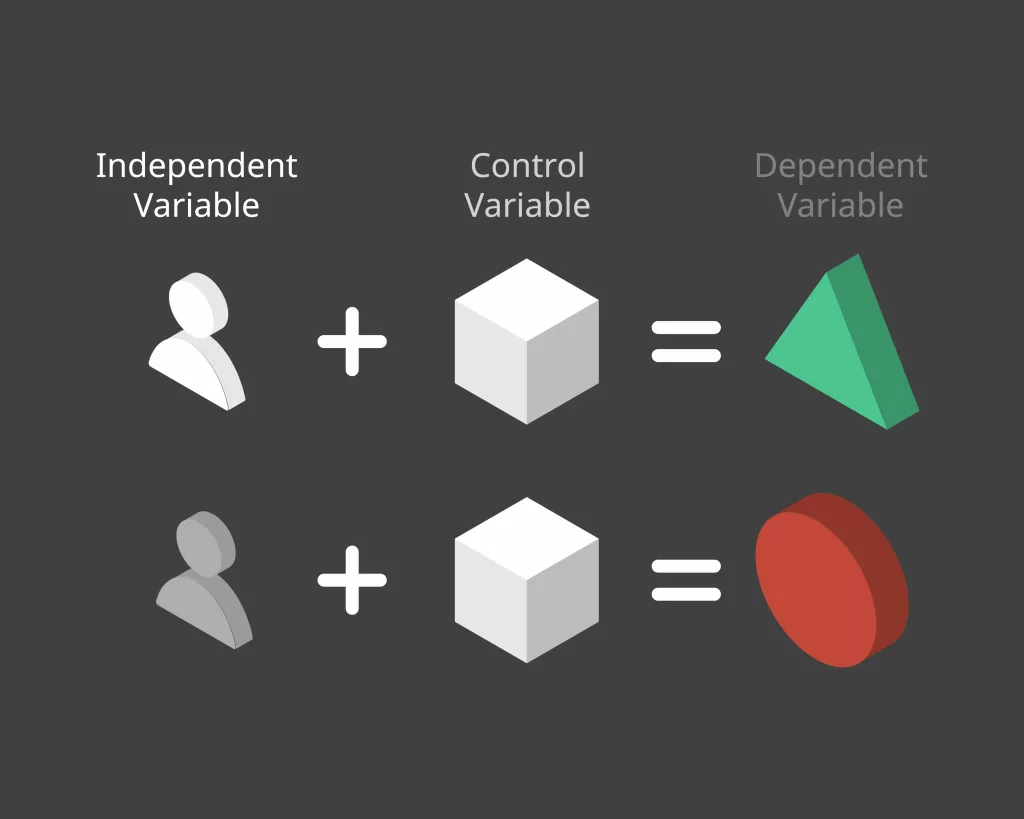Explore the essential roles of independent and dependent variables in research. This guide delves into their definitions, significance in experiments, and their critical relationship. Learn how these variables are the foundation of research design, influencing hypothesis testing, theory development, and statistical analysis, empowering researchers to understand and predict outcomes of research studies.
Table of Contents
Introduction
At the very base of scientific inquiry and research design, variables act as the fundamental steps, guiding the rhythm and direction of research. This is particularly true in human behavior research, where the quest to understand the complexities of human actions and reactions hinges on the meticulous manipulation and observation of these variables. At the heart of this endeavor lie two different types of variables, namely: independent and dependent variables, whose roles and interplay are critical in scientific discovery.
Understanding the distinction between independent and dependent variables is not merely an academic exercise; it is essential for anyone venturing into the field of research. This article aims to demystify these concepts, offering clarity on their definitions, roles, and the nuances of their relationship in the study of human behavior, and in science generally. We will cover hypothesis testing and theory development, illuminating how these variables serve as the cornerstone of experimental design and statistical analysis.

The significance of grasping the difference between independent and dependent variables extends beyond the confines of academia. It empowers researchers to design robust studies, enables critical evaluation of research findings, and fosters an appreciation for the complexity of human behavior research. As we delve into this exploration, our objective is clear: to equip readers with a deep understanding of these fundamental concepts, enhancing their ability to contribute to the ever-evolving field of human behavior research.
Chapter 1: The Role of Independent Variables in Human Behavior Research
In the realm of human behavior research, independent variables are the keystones around which studies are designed and hypotheses are tested. Independent variables are the factors or conditions that researchers manipulate or observe to examine their effects on dependent variables, which typically reflect aspects of human behavior or psychological phenomena. Understanding the role of independent variables is crucial for designing robust research methodologies, ensuring the reliability and validity of findings.
Defining Independent Variables
Independent variables are those variables that are changed or controlled in a scientific experiment to test the effects on dependent variables. In studies focusing on human behavior, these can range from psychological interventions (e.g., cognitive-behavioral therapy), environmental adjustments (e.g., noise levels, lighting, smells, etc), to societal factors (e.g., social media use). For example, in an experiment investigating the impact of sleep on cognitive performance, the amount of sleep participants receive is the independent variable.
Selection and Manipulation
Selecting an independent variable requires careful consideration of the research question and the theoretical framework guiding the study. Researchers must ensure that their chosen variable can be effectively, and consistently manipulated or measured and is ethically and practically feasible, particularly when dealing with human subjects.
Manipulating an independent variable involves creating different conditions (e.g., treatment vs. control groups) to observe how changes in the variable affect outcomes. For instance, researchers studying the effect of educational interventions on learning outcomes might vary the type of instructional material (digital vs. traditional) to assess differences in student performance.
Challenges in Human Behavior Research
Manipulating independent variables in human behavior research presents unique challenges. Ethical considerations are paramount, as interventions must not harm participants. For example, studies involving vulnerable populations or sensitive topics require rigorous ethical oversight to ensure that the manipulation of independent variables does not result in adverse effects.

Practical limitations also come into play, such as controlling for extraneous variables that could influence the outcomes. In the aforementioned example of sleep and cognitive performance, factors like caffeine consumption or stress levels could confound the results. Researchers employ various methodological strategies, such as random assignment and controlled environments, to mitigate these influences.
Chapter 2: Dependent Variables: Measuring Human Behavior
The dependent variable in human behavior research acts as a mirror, reflecting the outcomes or effects resulting from variations in the independent variable. It is the aspect of human experience or behavior that researchers aim to understand, predict, or change through their studies. This section explores how dependent variables are measured, the significance of their accurate measurement, and the inherent challenges in capturing the complexities of human behavior.
Defining Dependent Variables
Dependent variables are the responses or outcomes that researchers measure in an experiment, expecting them to vary as a direct result of changes in the independent variable. In the context of human behavior research, dependent variables could include measures of emotional well-being, cognitive performance, social interactions, or any other aspect of human behavior influenced by the experimental manipulation. For instance, in a study examining the effect of exercise on stress levels, stress level would be the dependent variable, measured through various psychological assessments or physiological markers.
Measurement Methods and Tools
Measuring dependent variables in human behavior research involves a diverse array of methodologies, ranging from self-reported questionnaires and interviews to physiological measurements and behavioral observations. The choice of measurement tool depends on the nature of the dependent variable and the objectives of the study.
- Self-reported Measures: Often used for assessing psychological states or subjective experiences, such as anxiety, satisfaction, or mood. These measures rely on participants’ introspection and honesty, posing challenges in terms of accuracy and bias.
- Behavioral Observations: Involve the direct observation and recording of participants’ behavior in natural or controlled settings. This method is used for behaviors that can be externally observed and quantified, such as social interactions or task performance.
- Physiological Measurements: Include the use of technology to measure physical responses that indicate psychological states, such as heart rate, cortisol levels, or brain activity. These measures can provide objective data about the physiological aspects of human behavior.
Reliability and Validity
The reliability and validity of the measurement of dependent variables are critical to the integrity of human behavior research.
- Reliability refers to the consistency of a measure; a reliable tool yields similar results under consistent conditions.
- Validity pertains to the accuracy of the measure; a valid tool accurately reflects the concept it aims to measure.
Ensuring reliability and validity often involves the use of established measurement instruments with proven track records, pilot testing new instruments, and applying rigorous statistical analyses to evaluate measurement properties.
Challenges in Measuring Human Behavior
Measuring human behavior presents challenges due to its complexity and the influence of multiple, often interrelated, variables. Researchers must contend with issues such as participant bias, environmental influences, and the subjective nature of many psychological constructs. Additionally, the dynamic nature of human behavior means that it can change over time, necessitating careful consideration of when and how measurements are taken.
Section 3: Relationship between Independent and Dependent Variables
Understanding the relationship between independent and dependent variables is at the core of research in human behavior. This relationship is what researchers aim to elucidate, whether they seek to explain, predict, or influence human actions and psychological states. This section explores the nature of this relationship, the means by which it is analyzed, and common misconceptions that may arise.
The Nature of the Relationship
The relationship between independent and dependent variables can manifest in various forms—direct, indirect, linear, nonlinear, and may be moderated or mediated by other variables. At its most basic, this relationship is often conceptualized as cause and effect: the independent variable (the cause) influences the dependent variable (the effect). For instance, increased physical activity (independent variable) may lead to decreased stress levels (dependent variable).
Analyzing the Relationship
Statistical analyses play a pivotal role in examining the relationship between independent and dependent variables. Techniques vary depending on the nature of the variables and the research design, ranging from simple correlation and regression analyses for quantifying the strength and form of relationships, to complex multivariate analyses for exploring relationships among multiple variables simultaneously.
- Correlation Analysis: Used to determine the degree to which two variables are related. However, it’s crucial to note that correlation does not imply causation.
- Regression Analysis: Goes a step further by not only assessing the strength of the relationship but also predicting the value of the dependent variable based on the independent variable.
- Experimental Design: Provides a more robust framework for inferring causality, where manipulation of the independent variable and control of confounding factors allow researchers to directly observe the impact on the dependent variable.

Causality vs. Correlation
A fundamental consideration in human behavior research is the distinction between causality and correlation. Causality implies that changes in the independent variable cause changes in the dependent variable. Correlation, on the other hand, indicates that two variables are related but does not establish a cause-effect relationship. Confounding variables may influence both, creating the appearance of a direct relationship where none exists. Understanding this distinction is crucial for accurate interpretation of research findings.
Common Misinterpretations
The complexity of human behavior and the myriad factors that influence it often lead to challenges in interpreting the relationship between independent and dependent variables. Researchers must be wary of:
- Overestimating the strength of causal relationships based on correlational data.
- Ignoring potential confounding variables that may influence the observed relationship.
- Assuming the directionality of the relationship without adequate evidence.
Conclusion
This exploration highlights the importance of understanding independent and dependent variables in human behavior research. Independent variables act as the initiating factors in experiments, influencing the observed behaviors, while dependent variables reflect the results of these influences, providing insights into human emotions and actions.
Ethical and practical challenges arise, especially in experiments involving human participants, necessitating careful consideration to respect participants’ well-being. The measurement of these variables is critical for testing theories and validating hypotheses, with their relationship offering potential insights into causality and correlation within human behavior.
Rigorous statistical analysis and cautious interpretation of findings are essential to avoid misconceptions. Overall, the study of these variables is fundamental to advancing human behavior research, guiding researchers towards deeper understanding and potential interventions to improve the human condition.
Free 44-page Experimental Design Guide
For Beginners and Intermediates
- Introduction to experimental methods
- Respondent management with groups and populations
- How to set up stimulus selection and arrangement












